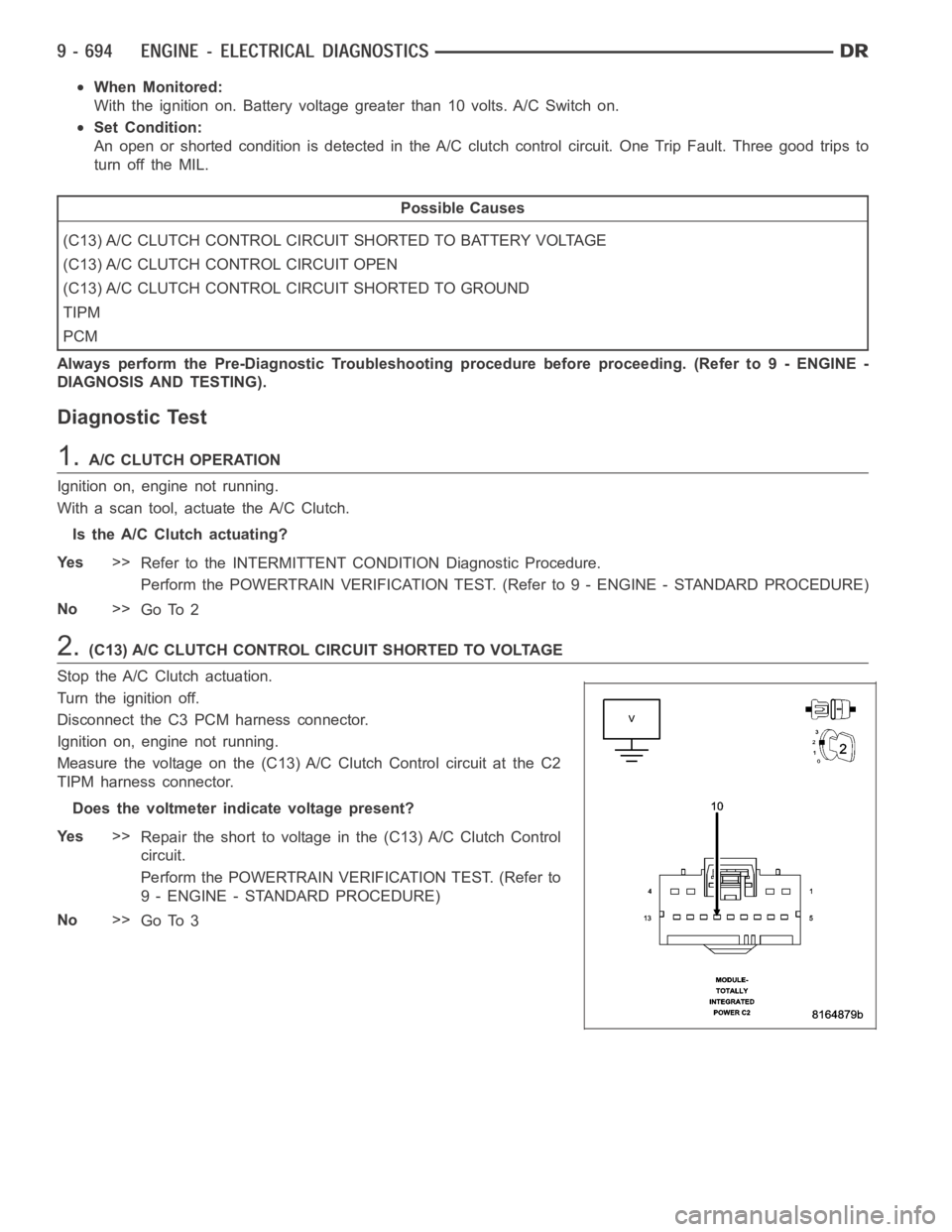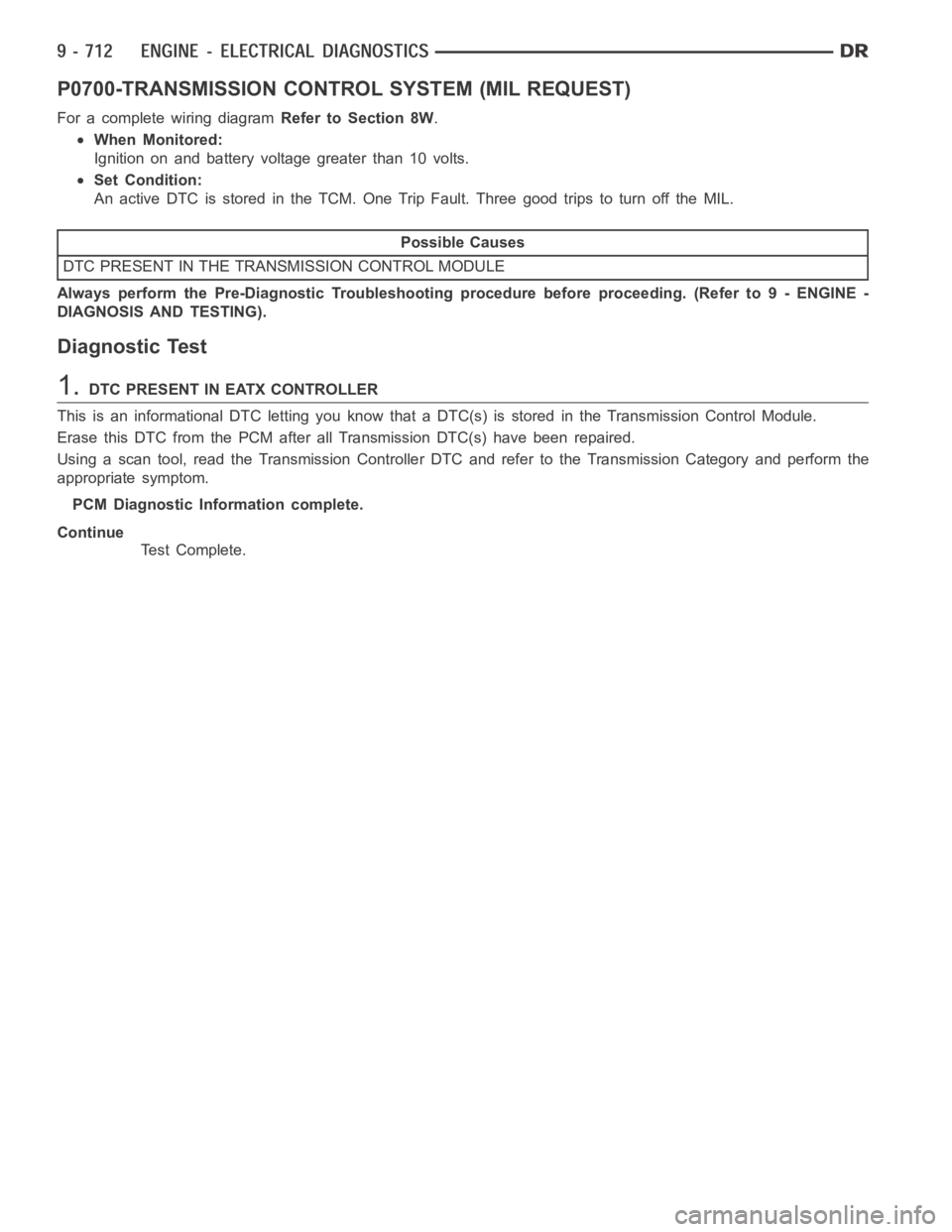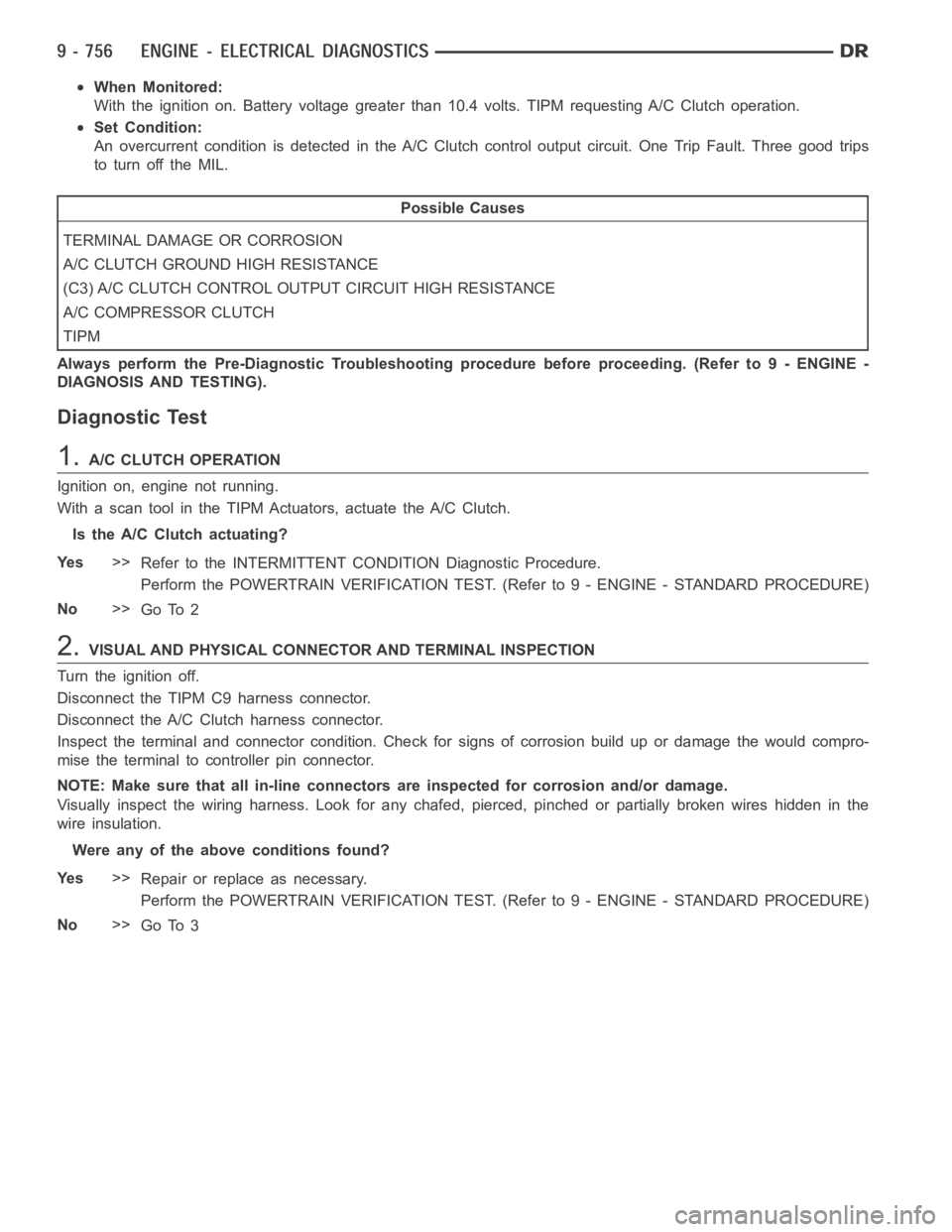2006 DODGE RAM SRT-10 air condition
[x] Cancel search: air conditionPage 3 of 5267

When Monitored:
With the ignition on. Battery voltage greater than 10 volts. A/C Switch on.
Set Condition:
An open or shorted condition is detected in the A/C clutch control circuit.One Trip Fault. Three good trips to
turn off the MIL.
Possible Causes
(C13) A/C CLUTCH CONTROL CIRCUIT SHORTED TO BATTERY VOLTAGE
(C13) A/C CLUTCH CONTROL CIRCUIT OPEN
(C13) A/C CLUTCH CONTROL CIRCUIT SHORTED TO GROUND
TIPM
PCM
Always perform the Pre-Diagnostic Troubleshooting procedure before proceeding. (Refer to 9 - ENGINE -
DIAGNOSIS AND TESTING).
Diagnostic Test
1.A/C CLUTCH OPERATION
Ignition on, engine not running.
With a scan tool, actuate the A/C Clutch.
Is the A/C Clutch actuating?
Ye s>>
Refer to the INTERMITTENT CONDITION Diagnostic Procedure.
Perform the POWERTRAIN VERIFICATION TEST. (Refer to 9 - ENGINE - STANDARD PROCEDURE)
No>>
Go To 2
2.(C13) A/C CLUTCH CONTROL CIRCUIT SHORTED TO VOLTAGE
Stop the A/C Clutch actuation.
Turn the ignition off.
Disconnect the C3 PCM harness connector.
Ignition on, engine not running.
Measure the voltage on the (C13) A/C Clutch Control circuit at the C2
TIPM harness connector.
Does the voltmeter indicate voltage present?
Ye s>>
Repair the short to voltage in the (C13) A/C Clutch Control
circuit.
Perform the POWERTRAIN VERIFICATION TEST. (Refer to
9 - ENGINE - STANDARD PROCEDURE)
No>>
Go To 3
Page 7 of 5267

When Monitored:
Ignition on.
Set Condition:
When the PCM recognizes the Auxiliary 5-volt Supply circuit voltage is toolow. One Trip Fault. ETC light is
flashing.
Possible Causes
(F856) AUXILIARY 5-VOLT SUPPLY SHORTED TO GROUND
SENSOR SHORTED TO GROUND
CAM POSITION SENSOR
PCM
Always perform the Pre-Diagnostic Troubleshooting procedure before proceeding. (Refer to 9 - ENGINE -
DIAGNOSIS AND TESTING).
Diagnostic Test
1.ACTIVE DTC
Ignition on, engine not running.
With a scan tool, read DTCs.
NOTE: Improperly installed aftermarket accessories can cause this DTC toset. Check for wiring added by
customer.
Is the DTC active at this time?
Ye s>>
Go To 2
No>>
Refer to the INTERMITTENT CONDITION Diagnostic Procedure.
Perform the POWERTRAIN VERIFICATION TEST. (Refer to 9 - ENGINE - STANDARD PROCEDURE)
2.(F856) AUXILIARY 5-VOLT SUPPLY SHORTED TO GROUND
Turn the ignition off.
Disconnect the C1 PCM harness connector.
Disconnect all the Sensors that share the (F856) Auxiliary 5-volt Supply
circuit.
Measure the resistance between ground and the (F856) Auxiliary 5-volt
Supply circuit in the CMP Sensor harness connector.
Istheresistancebelow100ohms?
Ye s>>
Repair the short to ground in the (F856) Auxiliary 5-volt
Supply circuit.
Perform the POWERTRAIN VERIFICATION TEST. (Refer to
9 - ENGINE - STANDARD PROCEDURE)
No>>
Go To 3
Page 10 of 5267

When Monitored:
Ignition on.
Set Condition:
When the PCM recognizes the Auxiliary 5-volt Supply circuit voltage is toohigh. One Trip Fault. ETC light is
flashing.
Possible Causes
(F856) AUXILIARY 5-VOLT SUPPLY SHORTED TO BATTERY VOLTAGE
PCM
Always perform the Pre-Diagnostic Troubleshooting procedure before proceeding. (Refer to 9 - ENGINE -
DIAGNOSIS AND TESTING).
Diagnostic Test
1.ACTIVE DTC
Ignition on, engine not running.
With a scan tool, read DTCs.
Is the DTC active at this time?
Ye s>>
Go To 2
No>>
Refer to the INTERMITTENT CONDITION Diagnostic Procedure.
Perform the POWERTRAIN VERIFICATION TEST. (Refer to 9 - ENGINE - STANDARD PROCEDURE)
2.(F856) AUXILIARY 5-VOLT SUPPLY SHORTED TO BATTERY VOLTAGE
Turn the ignition off.
Disconnect the C1 PCM harness connector.
Disconnect all the Sensors that share the (F856) Auxiliary 5-volt Supply
circuit.
NOTE: Improperly installed aftermarket accessories can cause this
DTC to set. Check for wiring added by customer.
Ignition on, engine not running.
Measure the voltage on the (F856) Auxiliary 5-volt Supply circuit at the
CMP Sensor harness connector.
Is the voltage above 0 volts?
Ye s>>
Repair the short to battery voltage in the (F856) Auxiliary
5-volt Supply circuit.
Perform the POWERTRAIN VERIFICATION TEST. (Refer to
9 - ENGINE - STANDARD PROCEDURE)
No>>
Go To 3
Page 13 of 5267

When Monitored:
With ignition on. Battery voltage above 10 volts.
Set Condition:
The actual ASD state is not equal to the desired ASD state. One Trip Fault. Three good trips to turn off the
MIL.
Possible Causes
INTERNAL FUSED B+ CIRCUITS
(K51) ASD RELAY CONTROL CIRCUIT OPEN
(K51) ASD RELAY CONTROL CIRCUIT SHORTED TO GROUND
ASD RELAY
PCM
Always perform the Pre-Diagnostic Troubleshooting procedure before proceeding. (Refer to 9 - ENGINE -
DIAGNOSIS AND TESTING).
Diagnostic Test
1.ASD RELAY OPERATION
Ignition on, engine not running.
With a scan tool, actuate the ASD Relay.
Is the ASD Relay operating?
Ye s>>
Refer to the INTERMITTENT CONDITION Diagnostic Procedure.
Perform the POWERTRAIN VERIFICATION TEST. (Refer to 9 - ENGINE - STANDARD PROCEDURE)
No>>
Go To 2
2.INTERNAL FUSED B+ CIRCUITS
Turn the ignition off.
Remove the ASD Relay from the IPM.
Using a 12-volt test light connected to ground, probe the Internal Fused
B+ circuits in the IPM.
Does the test light illuminate brightly?
Ye s>>
Go To 3
No>>
Repair the open or short to ground in the Internal Fused B+
circuits. Inspect and replace any open fuses.
Perform the POWERTRAIN VERIFICATION TEST. (Refer to
9 - ENGINE - STANDARD PROCEDURE)
3.ASD RELAY
Measure the resistance of the ASD Relay Coil.
Is the resistance between 60 to 80 ohms?
Ye s>>
Go To 4
No>>
Replace the ASD Relay.
Perform the POWERTRAIN VERIFICATION TEST. (Refer to 9 - ENGINE - STANDARD PROCEDURE)
Page 21 of 5267

P0700-TRANSMISSION CONTROL SYSTEM (MIL REQUEST)
For a complete wiring diagramRefer to Section 8W.
When Monitored:
Ignition on and battery voltage greater than 10 volts.
Set Condition:
An active DTC is stored in the TCM. One Trip Fault. Three good trips to turn offtheMIL.
Possible Causes
DTC PRESENT IN THE TRANSMISSION CONTROL MODULE
Always perform the Pre-Diagnostic Troubleshooting procedure before proceeding. (Refer to 9 - ENGINE -
DIAGNOSIS AND TESTING).
Diagnostic Test
1.DTC PRESENT IN EATX CONTROLLER
This is an informational DTC letting you know that a DTC(s) is stored in the Transmission Control Module.
Erase this DTC from the PCM after all Transmission DTC(s) have been repaired.
Using a scan tool, read the Transmission Controller DTC and refer to the Transmission Category and perform the
appropriate symptom.
PCM Diagnostic Information complete.
Continue
Te s t C o m p l e t e .
Page 23 of 5267

When Monitored:
Ignition on.
Set Condition:
When the PCM recognizes Brake Switch No.2 voltage is not equal to the applied value at the PCM when
Brake Switch No.1 is applied. This could be a normal condition. If this condition is seen repeatedly by the PCM
the fault is set. Cruise will not work for the rest of the key cycle.
Possible Causes
(V30)FUSEDIGNITIONSWITCHOUTPUTCIRCUIT
(V32) BRAKE SWITCH NO.2 SIGNAL CIRCUIT OPEN
(V32) BRAKE SWITCH NO.2 SIGNAL CIRCUIT SHORTED TO BATTERY VOLTAGE
(V32) BRAKE SWITCH NO.2 SIGNAL CIRCUIT SHORTED TO GROUND
(B29) BRAKE SWITCH NO.1 SIGNAL CIRCUIT OPEN
STOP LAMP SWITCH
PCM
Always perform the Pre-Diagnostic Troubleshooting procedure before proceeding. (Refer to 9 - ENGINE -
DIAGNOSIS AND TESTING).
Diagnostic Test
1.ACTIVE DTC
NOTE: Make sure the Stop Lamp Switch is adjusted properly before continuing.
NOTE: Make sure the Stop Lamp Switch is properly wired, such as (B29) Brake Switch No.1 and (L50) Brake
Lamp Switch Output are not switched at the harness connector.
Ignition on, engine not running.
With a scan tool, read DTCs.
Is the DTC active at this time?
Ye s>>
Go To 2
No>>
Refer to the INTERMITTENT CONDITION Diagnostic Procedure.
Perform the POWERTRAIN VERIFICATION TEST. (Refer to 9 - ENGINE - STANDARD PROCEDURE)
2.(V30) FUSED IGNITION SWITCH OUTPUT CIRCUIT
Turn the ignition off.
Disconnect the Stop Lamp Switch harness connector.
Using a 12-volt test light connected to ground, probe the (V30) Fused
Ignition Switch Output circuit in the Stop Lamp Switch harness connec-
tor.
Does the test light illuminate brightly?
Ye s>>
Go To 3
No>>
Repair the open or short to ground in the (V30) Fused Igni-
tion Switch Output circuit. Inspect the related fuse and
repair as necessary.
Perform the POWERTRAIN VERIFICATION TEST. (Refer to
9 - ENGINE - STANDARD PROCEDURE)
Page 32 of 5267

Theory of Operation
The General Temperature Rationality looks at the outputs of the three temperature sensors and compare them
under cold start conditions. Following a start to run delay time, the outputs of the ambient, engine coolant, and
intake air temperature sensors will be compared. If two sensors agree but not the third, the third sensor is declared
as irrational. If all three sensors are irrational the General Temperature Sensor Rationality is failed.
When Monitored:
Ignition on and battery voltage greater than 10 volts.
Set Condition:
Ambient Air, Engine Coolant, and Intake Air Temp sensor inputs are compared under cold start conditions.
After start up the temp readings are monitored. If two of the three readingsagree and the third doesn’t, a DTC
is stored. Two Trip Fault. Three good trips to turn off the MIL.
Possible Causes
EXCESSIVE RESISTANCE IN THE SENSOR SIGNAL CIRCUIT
EXCESSIVE RESISTANCE IN THE (K900) SENSOR GROUND CIRCUIT
EXCESSIVE RESISTANCE IN THE (G930) AAT RETURN CIRCUIT
TEMPERATURE SENSOR
PCM
Always perform the Pre-Diagnostic Troubleshooting procedure before proceeding. (Refer to 9 - ENGINE -
DIAGNOSIS AND TESTING).
Diagnostic Test
1.ACTIVE DTC
Ignition on, engine not running.
With a scan tool, read the DTCs.
NOTE: All ECT, Intake Air, and Ambient Air Temperature Sensor codes must bediagnosed and repaired
before continuing.
NOTE: In cold weather, this DTC could be set by a high powered block heater andnorepairwouldbe
required.
Is the DTC active at this time?
Ye s>>
Go To 2
No>>
Refer to the INTERMITTENT CONDITION Diagnostic Procedure.
Perform the POWERTRAIN VERIFICATION TEST. (Refer to 9 - ENGINE - STANDARD PROCEDURE)
2.TEMPERATURE SENSOR CIRCUIT
With a scan tool, read the ECT, Ambient Air Temp, and Intake Air Temp Sensor temp values.
Start the engine.
Allow the engine to reach normal operating temperature while monitoring the three Sensor temperature values.
Is the temperature for each of the Sensors increasing properly?
Ye s>>
Refer to the INTERMITTENT CONDITION Diagnostic Procedure.
Perform the POWERTRAIN VERIFICATION TEST. (Refer to 9 - ENGINE - STANDARD PROCEDURE)
No>>
Go To 3
Page 65 of 5267

When Monitored:
With the ignition on. Battery voltage greater than 10.4 volts. TIPM requesting A/C Clutch operation.
Set Condition:
An overcurrent condition is detected in the A/C Clutch control output circuit. One Trip Fault. Three good trips
to turn off the MIL.
Possible Causes
TERMINAL DAMAGE OR CORROSION
A/C CLUTCH GROUND HIGH RESISTANCE
(C3) A/C CLUTCH CONTROL OUTPUT CIRCUIT HIGH RESISTANCE
A/C COMPRESSOR CLUTCH
TIPM
Always perform the Pre-Diagnostic Troubleshooting procedure before proceeding. (Refer to 9 - ENGINE -
DIAGNOSIS AND TESTING).
Diagnostic Test
1.A/C CLUTCH OPERATION
Ignition on, engine not running.
With a scan tool in the TIPM Actuators, actuate the A/C Clutch.
Is the A/C Clutch actuating?
Ye s>>
Refer to the INTERMITTENT CONDITION Diagnostic Procedure.
Perform the POWERTRAIN VERIFICATION TEST. (Refer to 9 - ENGINE - STANDARD PROCEDURE)
No>>
Go To 2
2.VISUAL AND PHYSICAL CONNECTOR AND TERMINAL INSPECTION
Turn the ignition off.
Disconnect the TIPM C9 harness connector.
Disconnect the A/C Clutch harness connector.
Inspect the terminal and connector condition. Check for signs of corrosion build up or damage the would compro-
mise the terminal to controller pin connector.
NOTE: Make sure that all in-line connectors are inspected for corrosion and/or damage.
Visually inspect the wiring harness. Look for any chafed, pierced, pinched or partially broken wires hidden in the
wire insulation.
Were any of the above conditions found?
Ye s>>
Repair or replace as necessary.
Perform the POWERTRAIN VERIFICATION TEST. (Refer to 9 - ENGINE - STANDARD PROCEDURE)
No>>
Go To 3